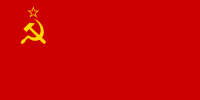
Back القوات المسلحة السوفيتية Arabic Fuercies Armaes Soviétiques AST SSRİ Silahlı Qüvvələri AZ СССР Ҡораллы Көстәре BA Узброеныя Сілы СССР BE Узброеныя сілы СССР BE-X-OLD সোভিয়েত সশস্ত্র বাহিনী Bengali/Bangla Forces Armades de la Unió Soviètica Catalan Советан Социалистийн Республикан Союзан герзаца болу ницкъаш CE Ozbrojené síly SSSR Czech
| Armed Forces of the Union of Soviet Socialist Republics | |
|---|---|
| Вооружённые Силы Союза Советских Социалистических Республик Vooruzhonnyye Sily Soyuza Sovetskikh Sotsialisticheskikh Respublik | |
 | |
 The Soviet flag was also being used as the Banner of the USSR Armed Forces | |
| Founded | 23 February 1918 (as the Red Army) 25 February 1946 (as the Soviet Armed Forces) |
| Disbanded | 26 December 1991 (Soviet Union dissolved) 24 December 1993[1] (United Armed Forces disbanded) |
| Service branches | Soviet Army Soviet Air Forces Soviet Air Defence Forces Strategic Rocket Forces Soviet Navy[2] Soviet Airborne Forces |
| Headquarters | Ministry of Defence, Khamovniki District, Moscow, RSFSR |
| Leadership | |
| General Secretary | Joseph Stalin (1922–1953) Mikhail Gorbachev (1985–1991) |
| Minister of Defence |
|
| Chief of the General Staff |
|
| Personnel | |
| Military age | 18–35 |
| Conscription | 2 years (Army & Air Force) 3 years (Navy) |
| Available for military service | 92,345,764 (1991), age 18–35 |
| Active personnel | 4,900,000 (1985) |
| Reserve personnel | 12,750,000 |
| Expenditure | |
| Budget | US$128 billion (official, 1988)[3] US$200-300 billion (CIA, Pentagon estimate, 1988)[4] |
| Percent of GDP | 4.9% (official, 1988) 7.7–11.5% (CIA, Pentagon estimate, 1988) |
| Related articles | |
| History | Military history of the Soviet Union |
| Ranks | Military ranks of the Soviet Union |
The Soviet Armed Forces,[a] also known as the Armed Forces of the Soviet Union,[b] the Red Army (1918–1946) and the Soviet Army (1946–1991), were the armed forces of the Russian SFSR (1917–1922) and the Soviet Union (1922–1991) from their beginnings in the Russian Civil War of 1917–1923 to the collapse of the USSR in 1991. In May 1992, Russian President Boris Yeltsin issued decrees forming the Russian Armed Forces, which subsumed much of the Soviet Armed Forces. Multiple sections of the former Soviet Armed Forces in the other, smaller Soviet republics gradually came under those republics' control.
According to the all-union military service law of September 1925, the Soviet Armed Forces consisted of the Ground Forces, the Air Forces, the Navy, the State Political Directorate (OGPU), and the convoy guards.[5] The OGPU was later made independent and amalgamated with the NKVD in 1934, and thus its Internal Troops were under the joint management of the Defence and Interior Commissariats. In 1989, the Soviet Armed Forces consisted of the Strategic Rocket Forces, the Ground Forces, the Air Defence Forces, the Air Forces, and the Navy, listed in their official order of importance.[2]
In the USSR, general conscription applied, which meant that all able-bodied males aged eighteen and older were drafted into the armed forces.[6] International observers regarded the armed organizations as collectively one of the strongest such forces in world history.[7] The relative advancement and development of the government's militaries was a key part of the history of the USSR.
In the context of the Cold War, an academic study by the rival U.S. Department of Defense in 1984 found that the Soviets maintained a notable reach across the world and particularly inside Europe. The analysis explicitly concluded that "Soviet armies have always been massive" while "they are also highly modernized, well-equipped, and have great firepower... [as well as] mobility", which meant that "manpower and materiel combined make the present Soviet ground forces a very formidable land army." Although Soviet military strategy in general merited comment, "the ground forces constituted the largest of the five Soviet military services" as of the date the research ended.[7]
- ^ "Loading". Archived from the original on 2015-05-11. Retrieved 2017-03-03.
- ^ a b Zickel & Keefe 1991, p. 697.
- ^ "Soviet Military Budget: $128 Billion Bombshell". The New York Times. 31 May 1989. Archived from the original on 2017-03-12. Retrieved 2017-02-12.
- ^ "Soviets to trim military production by 1990". Defense Daily. 24 July 1989. Archived from the original on 24 September 2015. Retrieved 9 August 2015.; "Soviet military spending put at 20–25% of GNP". Defense Daily. 24 April 1990. Archived from the original on 24 September 2015. Retrieved 9 August 2015.; "Soviets have not hardened position on SLCM – Akhromeyev". Defense Daily. 9 May 1990. Archived from the original on 24 September 2015. Retrieved 9 August 2015.
- ^ Scott & Scott 1979, p. 13.
- ^ "Принят закон "О всеобщей воинской обязанности"". Translated by A law on the mandatory military draft. prlib.ru. 12 October 1967.
- ^ a b "The Soviet Army: Operations and Tactics". United States Department of Defense - Department of the Army. Field Manual (No. 100-2-1). 16 July 1984. Washington, D.C.
Cite error: There are <ref group=lower-alpha> tags or {{efn}} templates on this page, but the references will not show without a {{reflist|group=lower-alpha}} template or {{notelist}} template (see the help page).